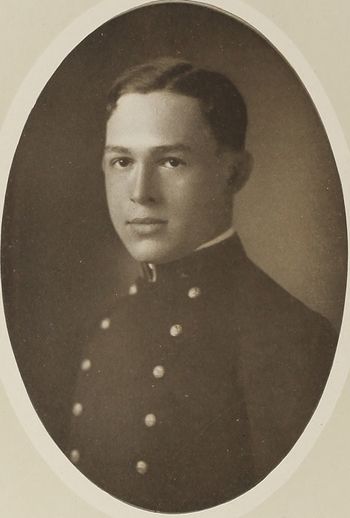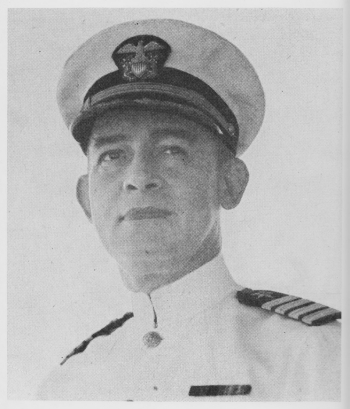FRANKLIN VAN VALKENBURGH, CAPT, USN
Franklin Van Valkenburgh '09
Lucky Bag
From the 1909 Lucky Bag:
Franklin Van Valkenburgh
Milwaukee, Wisconsin
"Van," "Dutch"
His name and native city signify that Van indulges in the beverage that made Milwaukee famous; despite this, he was a delegate to Northfield.
Always greets you in the pleasant way that shows his comfortable, optimistic view of life. His warm, affectionate nature may manifest itself in either a handshake, a knockout blow on the back, or a hearty hug. Easy-going but very sensitive, those big ears will turn red at the slightest provocation. He manages to get along without much worry. The day he entered, his hopes of becoming an officer, as they appeared to him, were very slight, for a few minutes after signing away his liberty for eight years and swearing to honor, to defend and to protect his country, he was taken to room 343 and there initiated to all its unique stunts. How many can recall the happy moments spent there?
Van finds complete happiness in devoting his lazy energies to Bible Study, kodaking and a 2.51.
"Van, feather those ears."
Buzzard. Chairman Y.M.C.A. Bible Study.

Franklin Van Valkenburgh
Milwaukee, Wisconsin
"Van," "Dutch"
His name and native city signify that Van indulges in the beverage that made Milwaukee famous; despite this, he was a delegate to Northfield.
Always greets you in the pleasant way that shows his comfortable, optimistic view of life. His warm, affectionate nature may manifest itself in either a handshake, a knockout blow on the back, or a hearty hug. Easy-going but very sensitive, those big ears will turn red at the slightest provocation. He manages to get along without much worry. The day he entered, his hopes of becoming an officer, as they appeared to him, were very slight, for a few minutes after signing away his liberty for eight years and swearing to honor, to defend and to protect his country, he was taken to room 343 and there initiated to all its unique stunts. How many can recall the happy moments spent there?
Van finds complete happiness in devoting his lazy energies to Bible Study, kodaking and a 2.51.
"Van, feather those ears."
Buzzard. Chairman Y.M.C.A. Bible Study.
Loss
Franklin was killed in action on December 7, 1941 when his ship, USS Arizona (BB 39) was destroyed at Pearl Harbor.
Other Information
From Wikipedia:
Born in Minneapolis, Van Valkenburgh moved to Milwaukee when he was a toddler. His father was a prominent lawyer also named Franklin Van Valkenburgh, who served as Milwaukee assistant city attorney and a U.S. attorney for Wisconsin. His great-grandmother’s brother was Daniel Wells Jr., who represented Wisconsin's 1st Congressional District in the 1850s. He grew up on Milwaukee’s east side, attending Cass Elementary School and graduating from East Side High School, later renamed Riverside High School.
Franklin Van Valkenburgh was appointed a midshipman at the United States Naval Academy on September 15, 1905, and graduated on June 4, 1909. After service in the battleship USS Vermont (BB-20) and in USS South Carolina, Van Valkenburgh was commissioned ensign on June 5, 1911. Traveling to the Asiatic Station soon thereafter, he joined the submarine tender USS Rainbow (AS-7) at Olongapo, Philippine Islands, on September 11,. He reported to the gunboat USS Pampanga (PG-39) as executive officer on June 23, 1914, for a short tour in the southern Philippines before his detachment on August 4,.
After returning to the United States, Lt. (jg.) Van Valkenburgh joined USS Connecticut (BB-18) on November 11,. Following postgraduate work in steam engineering at the Naval Academy in September 1915, he took further instruction in that field at Columbia University before reporting to USS Rhode Island (BB-17) on March 2, 1917. The entry of the United States into World War I found Van Valkenburgh serving as the battleship's engineering officer. Subsequent temporary duty in the receiving ship at New York preceded his first tour as an instructor at the Naval Academy. On June 1, 1920, Van Valkenburgh reported on board USS Minnesota (BB-22) for duty as engineer officer, and he held that post until the battleship was decommissioned in November 1921.
He again served as an instructor at the Naval Academy—until May 15, 1925—before he joined USS Maryland (BB-46) on June 26,. Commissioned commander on June 2, 1927, while in Maryland, he soon reported for duty in the Office of the Chief of Naval Operations on May 21, 1928, and served there during the administrations of Admirals Charles F. Hughes and William V. Pratt. Detached on June 28, 1931, Van Valkenburgh received command of the destroyer USS Talbot (DD-114) on July 10, and commanded Destroyer Squadron 5 from March 31, 1932.
After attending the Naval War College, Newport, R.I., and completing the senior course in May 1934, Comdr. Van Valkenburgh next served as inspector of naval materiel at the New York Navy Yard before going to sea again as commanding officer of USS Melville (AD-2) from June 8, 1936, to June 11, 1938. Promoted to captain while commanding Melville—on December 23, 1937—he served as inspector of material for the 3d Naval District from August 6, 1938, to January 22, 1941.
On February 5, 1941, Van Valkenburgh relieved Capt. Harold C. Train as commanding officer of USS Arizona (BB-39). Newly refitted at Puget Sound Naval Shipyard, Arizona served as flagship of Battleship Division 1 for the remainder of the year, based primarily at Pearl Harbor with two trips to the west coast.
In a letter to a relative, Faith Van Valkenburgh Vilas, dated November 4, 1941, Captain Van Valkenburgh wrote: "We are training, preparing, maneuvering, doing everything we can do to be ready. The work is intensive, continuous, and carefully planned. We never go to sea without being completely ready to move on to Singapore if need be, without further preparation. Most of our work we are not allowed to talk about off of the ship. I have spent 16 to 20 hours a day on the bridge for a week at a time, then a week of rest, then at it again.
"Our eyes are constantly trained Westward, and we keep the guns ready for instant use against aircraft or submarines whenever we are at sea. We have no intention of being caught napping."
On December 4, the battleship went to sea in company with USS Nevada (BB-36) and USS Oklahoma (BB-37) for night surface practice and, after conducting these gunnery exercises, returned to Pearl Harbor independently on the 6th to moor at berth F-7 alongside Ford Island.
Both Captain Van Valkenburgh and the embarked division commander, Rear Admiral Isaac C. Kidd, spent the next Saturday evening, December 6, on board. Suddenly, shortly before 08:00 on December 7, Japanese planes roared overhead, shattering the Sunday peace and punctuating it with the explosion of bombs and the staccato hammering of machine guns. Captain Van Valkenburgh ran from his cabin and arrived on the navigation bridge, where he immediately began to direct his ship's defense. A quartermaster in the pilot house asked if the captain wanted to go to the conning tower—a less-exposed position in view of the Japanese strafing—but Captain Van Valkenburgh adamantly refused and continued to man a telephone, fighting for his ship's life.
A violent explosion suddenly shook the ship, throwing the three occupants of the bridge—Captain Van Valkenburgh, an ensign, and the quartermaster, to the deck, and blowing out all of the bridge windows completely. Dazed, battered and shaken, the ensign stumbled through the flames and smoke of the shattered bridge's interior and escaped, but Captain Van Valkenburgh and the quartermaster were never seen again. A continuing fire, fed by ammunition and oil, raged for two days until finally being extinguished on December 9. Despite a thorough search, Captain Van Valkenburgh's body was never found; all that was ever retrieved was his Annapolis class ring.
He was survived by his wife, two daughters, and son. He has a memory marker in Wisconsin.
Photographs
Medal of Honor
From Hall of Valor:
The President of the United States of America, in the name of Congress, takes pride in presenting the Medal of Honor (Posthumously) to Captain Franklin Van Valkenburgh (NSN: 0-7187), United States Navy, for distinguished conduct in action, outstanding heroism, and utter disregard of his own safety above and beyond the call of duty during the attack on the Fleet in Pearl Harbor, Territory of Hawaii, by Japanese forces on 7 December 1941. As Commanding Officer of the U.S.S. ARIZONA (BB-39), Captain Van Valkenburgh gallantly fought his ship until the U.S.S. ARIZONA blew up from magazine explosions and a direct bomb hit on the bridge which resulted in the loss of his life.
Service: Navy
Division: U.S.S. Arizona (BB-39)
Namesake
USS Van Valkenburgh (DD 656) was named for Franklin; the ship was sponsored by his widow, Marguerite. "The ensign hoisted upon commissioning that afternoon was the same that had flown above Arizona's fantail at Pearl Harbor on the morning of 7 December 1941."
The "Register of Commissioned and Warrant Officers of the United States Navy and Marine Corps" was published annually from 1815 through at least the 1970s; it provided rank, command or station, and occasionally billet until the beginning of World War II when command/station was no longer included. Scanned copies were reviewed and data entered from the mid-1840s through 1922, when more-frequent Navy Directories were available.
The Navy Directory was a publication that provided information on the command, billet, and rank of every active and retired naval officer. Single editions have been found online from January 1915 and March 1918, and then from three to six editions per year from 1923 through 1940; the final edition is from April 1941.
The entries in both series of documents are sometimes cryptic and confusing. They are often inconsistent, even within an edition, with the name of commands; this is especially true for aviation squadrons in the 1920s and early 1930s.
Alumni listed at the same command may or may not have had significant interactions; they could have shared a stateroom or workspace, stood many hours of watch together… or, especially at the larger commands, they might not have known each other at all. The information provides the opportunity to draw connections that are otherwise invisible, though, and gives a fuller view of the professional experiences of these alumni in Memorial Hall.
January 1910
January 1911
January 1912
January 1913
January 1914
January 1915
January 1916
January 1917
March 1918
January 1919
January 1920
January 1921
January 1922
May 1923
July 1923
September 1923
November 1923
January 1924
March 1924
May 1924
July 1924
September 1924
November 1924
January 1925
March 1925
May 1925
July 1925
October 1925
January 1926
October 1926
January 1927
April 1927
October 1927
January 1928
April 1928
July 1928
October 1928
January 1929
April 1929
July 1929
October 1929
January 1930
April 1930
October 1930
January 1931
July 1931
October 1931
January 1932
April 1932
October 1932
January 1933
April 1933
July 1933
October 1933
April 1934
July 1934
October 1934
January 1935
April 1935
October 1935
January 1936
April 1936
July 1936
January 1937
April 1937
September 1937
January 1938
July 1938
January 1939
October 1939
June 1940
November 1940
April 1941

The "category" links below lead to lists of related Honorees; use them to explore further the service and sacrifice of alumni in Memorial Hall.

